During lactation, taking painkillers requires special care. Most drugs are excreted in milk. They can harm the baby, provoking allergies, poisoning, and intestinal upset. In case of migraine, toothache or other painful conditions, it is necessary to make sure that the medicine taken will not harm the baby.
Record content:
- 1 Causes and factors of headaches in nursing mothers
- 2 Types of headaches when it is worth taking pills
-
3 Permitted pills for one-time headache
- 3.1 Paracetamol
- 3.2 Ibuprofen
- 3.3 No-shpa
- 3.4 Naproxen Actavis
- 3.5 Ketorolac
-
4 Prohibited pills
- 4.1 Aspirin
- 4.2 Citramon
- 4.3 Analgin
- 4.4 Other
- 5 How to do without medication while breastfeeding?
- 6 When do I have to interrupt HB for the sake of treatment?
- 7 Headache Pill Videos
Causes and factors of headaches in nursing mothers
Pills headache (when breastfeeding, a change in hormonal levels, lack of sleep, experiences often become sources of headaches) is prescribed only by a doctor.
Tension pain (tension pain) occurs as a result of:
- Stress, hormonal changes in the body. After childbirth, oxytocin (a hormone that enhances maternal instinct) rises, which leads to increased feelings of anxiety in the mother.
- Premenstrual Syndrome. Often the monthly cycle is restored at 3-4 months of breastfeeding.
- Malnutrition. In the first months, a young mother may not have time to comply with the diet. Irregular meals and snacks on the go do not provide the right amount of nutrients for breastfeeding and postpartum recovery.
- Hypertension or hypotension.

- Chronic sleep deprivation. Due to breastfeeding (breastfeeding) at night, mothers sleep at intervals of 3 hours. Intermittent, poor-quality sleep for a long time leads to chronic fatigue, against which migraine attacks develop.
- Oxygen starvation. Trying to protect the baby from drafts, parents rarely ventilate, and this reduces the level of oxygen and humidity in the room.
- Breastfeeding in an awkward position. It leads to excessive tension of the neck muscle group, disruption of blood supply, provoking not only the appearance of painful spasms in the head, but also osteochondrosis.
Often the causes of headaches are:
- Consequences of epidural anesthesia.
- Diseases of the ears, throat, nose (otitis media, sinusitis).
- Infectious diseases (ARVI, influenza).
- Meteorological dependence.
- Poisoning, including carbon monoxide, household chemicals.
From the 1st to the 3rd months after the birth of the child, the mother gets used to the new schedule. Day and night feedings, household chores, unstable hormonal levels lead to exhaustion, increased mental sensitivity, and nervous breakdowns.
These factors can trigger migraine attacks. Attacks of nausea, painful sensations from sharp sounds and light are added to the headache.
Types of headaches when it is worth taking pills
The origin of headaches is divided into:
| Primary | Secondary |
| Arise by themselves | Due to illness (colds, hypotension) |
Primary headaches:
| Kind of pain | Common causes of occurrence | Character | Intensity | Duration |
| Stress pain | Physical or mental overload of the body | Feels like a dull, squeezing head like a hoop, ring pain. | Weak, medium. Gives to the temples, forehead, back of the head. | May not go away from ½ hour to 8 days |
| Migraine | Manifestations of neuralgia | Single or repeated bouts of throbbing pain that are aggravated by emotion or any movement | Medium, strong. Often the temporal, occipital or occipital region of the head hurts. Often the pain is accompanied by nausea, fear of light. | 4 to 72 h |
| Cluster pain | Occurs due to vascular pathologies | Sharp, cutting, often one-sided pain | Average. Pain in the eye area, radiating to the temporal or frontal part of the head. It is accompanied by increased sweating, redness and swelling of the eye. | From ¼ to 5-6 hours |
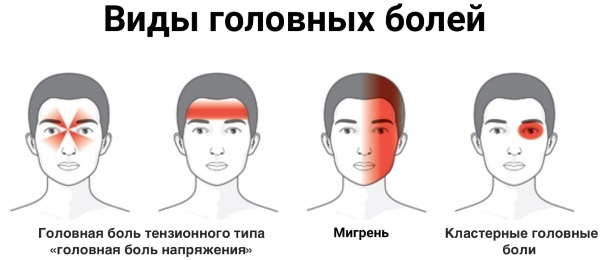
Headaches that recur more than 15 days a month for 3 months are considered chronic.
Secondary headaches begin as a result of:
- Infectious diseases (colds, meningitis, encephalitis).
- Head and neck injuries.
- Cardiovascular disease. They are often accompanied by visual impairment, discomfort in the eyes, and edema. The appetite is also disturbed, the state of health worsens.
- Food, chemical, drug poisoning.
- Brain tumors.
Pills for headache during breastfeeding, when pain is a secondary sign of a disease, are taken after a doctor's prescription. Some analgesics cannot be used for viral infections, and only a doctor can determine the cause of the disease.
If the prescribed drugs are not compatible with hepatitis B, the child is fed with formula or previously expressed milk; in the case of a long course of treatment, the milk can be frozen.
Expressed milk storage times:
| + 16 to + 29 | 4-5 hours, in a sterile container (8 hours) |
| +4 to -4 (refrigerator) | 5-7 days |
| -17С (freezer) | 3-6 months |
Freezing breast milk, doctors advise only if it will not be used within 7 days.
When treating episodic headache without medication, the following are effective:
- Relaxing shower.
- Walk in the fresh air.
- An ice compress applied to the diseased parts of the head for 10-15 minutes.
- Head massage.
- Dream.

When breastfeeding, the benefits of pain relievers used to treat headaches should be weighed against the risk harm the child and do not forget that a healthy mother is more necessary for the baby than her milk, which can be replaced with milk mixtures.
Permitted pills for one-time headache
Breastfeeding headache pills (from the list of medicines approved by doctors) are quickly excreted from the body and have a low percentage of excretion in breast milk.
But even in these cases, the rules for taking medicinal products should be observed:
- Before taking the drug for the first time, it is necessary to study the annotation even if the doctor prescribes the medicine.
- Do not exceed the dosage of the medication.
- It is necessary to take the product immediately before feeding, this will prevent the active substances from getting into the milk.
1-1.5 hours after taking the medication, breast milk is expressed. It is no longer possible to give it to a child.
Paracetamol
The active ingredient is paracetamol. It is used for mild to moderate pain, neuralgia. Often used as an antipyretic, it also has analgesic and anti-inflammatory effects. Paracetamol slows down the synthesis of prostaglandins in the central nervous system, blocks the conduction of pain impulses.
Produced in the form:
- Candles.
- Syrup.
- Pills.
A contraindication is chronic alcoholism and allergic reactions.
Drug analogues:
- Panadol.
- Cefekon.
- Efferalgan.
The drug is quickly excreted from the body and is not toxic to the baby. Paracetamol-based products are allowed to be used from 1 month of a child's life. The tablets are taken no more than 4 times a day, the duration of treatment is 3 days. A single dosage of the drug is 500 mg, repeated administration of the drug is possible after 4 hours, the time of the analgesic effect is 4-6 hours.
Ibuprofen
The drug is prescribed for the treatment of migraines and tension headaches, as well as an analgesic and antipyretic agent for colds. Ibuprofen will help relieve pain symptoms, spasms.
It blocks pain by inhibiting the biosynthesis of pain mediators and relieves inflammation. The use of this medication requires the compulsory expression of milk. The main active ingredient is ibuprofen, a non-steroidal anti-inflammatory drug.
Analogs:
- Nurofen.
- Suprafen.
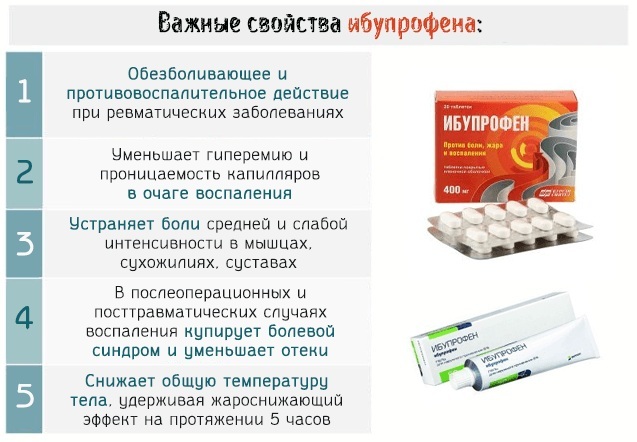
Use with caution in diseases of the gastrointestinal tract, arterial hypertension, diabetes mellitus. Ibuprofen should not be used during the 3rd trimester of pregnancy. It is taken at intervals of 8 hours, a maximum of 3 times a day, a dosage of 200-400 mg. It is recommended to drink the tablets with a glass of water. The analgesic effect occurs in 20-30 minutes and lasts up to 12 hours.
No-shpa
The drug is effective for tension headaches. The active ingredient (drotaverine) slows down the activity of PDEZ-4 (an enzyme responsible for contractile activity of smooth muscle tissue), relieving smooth muscle spasms of muscle and neurogenic type.
Drug analogs:
- Drotaverine hydrochloride.
- Spazmanet.
Maximum dosage 160 mg per day, treatment regimen:
- 1 tablet (40 mg) - 1-4 rubles / day.
- 2 tablets (80 mg) - 1-2 rubles / day.
The medicine will not be effective for headaches caused by colds, migraines.
Naproxen Actavis
The drug belongs to non-steroidal anti-inflammatory drugs, the active ingredient (naproxen sodium). The analgesic and anti-inflammatory effect is achieved by slowing down the activity of the enzyme cyclooxygenase, which leads to a violation of the synthesis of prostaglandins. The tablets are taken with meals, at a dosage of 500-1000 mg, no more than 2 times a day.
The product is compatible with HS only with a single use. Its long-term use in 10% of the application causes drowsiness in infants. It is not recommended to use Naproxen if the baby has newborn jaundice.
Ketorolac
The active ingredient of ketorolac tromethamine blocks the activity of the enzymes COX-1 and COX-2, which leads to a decrease in the level of prostaglandins (reduction of pain). 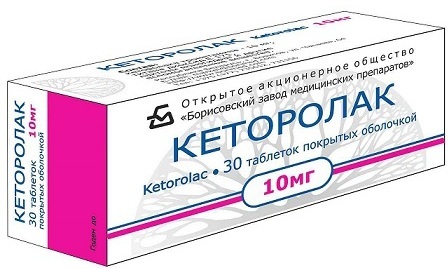
Produced in the form:
- Pills. A single dose - 10 mg, it is allowed to take up to 4 times a day.
- Injections. A single dose of 10-30 ml is administered intramuscularly or intravenously.
When taken orally, ketorolac is excreted in breast milk.
Active ingredient level in milk, 2 hours after taking a 10mg tablet:
| 1 dose | 7.3 ng / ml |
| 2 dose | 7.9 ng / ml |
When injected, the excretion of the drug in breast milk is reduced.
Prohibited pills
A number of drugs that are common in everyday life become prohibited during breastfeeding. Immature enzyme systems and a child's liver take longer to metabolize and remove the drug from the body than in an adult.
Therefore, even if a small percentage of the drug enters breast milk, due to its prolonged circulation throughout the body, the child may receive an overdose or poisoning. As a result, side effects and allergic reactions intensify, often affecting the liver and gastrointestinal tract.
Aspirin
The active substance, acetylsalicylic acid, belongs to strong allergens.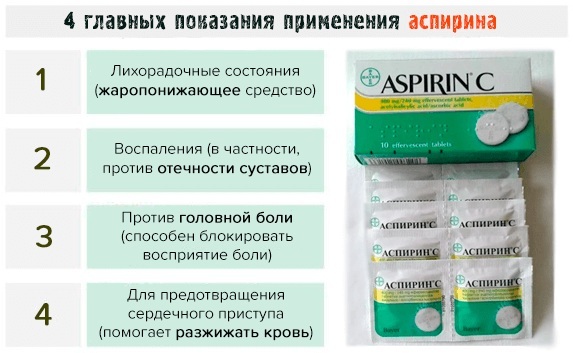
The drug must not be taken:
- Children under 15 yrs. Taking medication can cause severe complications (asthma attacks, kidney failure, Ray syndrome)
- In viral infections (in viral diseases, it destroys the liver).
In case of hepatitis B with milk, up to 8% of the dose taken is excreted. With repeated use, the medicine excreted with milk can lead to decreased blood clotting in a child, hematomas that appear as a result of hemorrhages, hemorrhagic diathesis.
Citramon
The drug consists of 3 main components:
- Acetylsalicylic acid - 240 mg
- Caffeine - 30 mg
- Cocoa - 15 mg
The composition of citramone P additionally includes paracetamol.
The negative effects of aspirin and caffeine on infants are stronger than on their mothers. They can provoke the appearance of erosions and ulcers, migraines and dizziness in a child. Caffeine, even with a single use, increases the excitability of the baby, he becomes nervous, capricious, and does not sleep well.
Analgin
The drug is harmful to children under 3 months of age. In 85% of cases, the use of the drug by the mother during hepatitis B led to allergic reactions in the child.
They manifested themselves in the form:
- Hives.
- Peeling and blemishes on the skin.
- Quincke's edema.
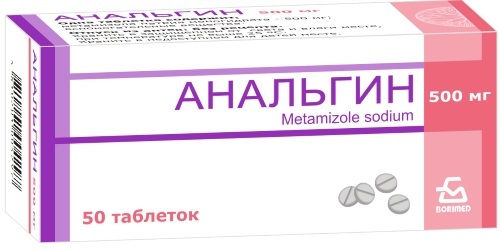
The main substance (metamizole sodium) during breastfeeding negatively affects the composition of the child's blood, disrupts the functioning of the liver and kidneys. Analgin in 2009 was struck off the list of required drugs due to increased toxicity.
In the absence of approved pain relievers, a one-time medication is allowed. Its dose should not exceed 1 mg per day. If a long-term use of the drug is planned, the child is transferred to a mixture, since any form of this drug will be excreted in milk.
Other
It is not allowed to use during breastfeeding preparations containing:
- Ergotamine (cornutamine, nomigren, rigetamine). It can provoke convulsions, tachycardia, bradycardia.
- Barbiturates (butalbital). Derivatives of barbituric acid have a depressing effect on the nervous system and cause addiction.
- Codeines (solpadein, panadein). The opium alkaloid has a weak narcotic effect and disrupts respiratory activity.
- Caffeine (kaffetin, pentalgin plus). The drug has an exciting effect on the nervous system, provokes nausea, vomiting, leukopenia.
While taking drugs prohibited by pediatricians, 1-3 breastfeeds are skipped, milk is expressed. The baby is temporarily fed with formula. The number of breastfeeding skips depends on the time the medication is withdrawn.
How to do without medication while breastfeeding?
Get rid of a headache, if it is not a symptom of a serious illness, recipes of traditional medicine will help:
- Herbal teas and herbal teas, when consumed consistently, provide a relaxing and soothing effect. During lactation, it is allowed to drink tea from the leaves of lemon balm, linden, eucalyptus. Do not drink lavender tea as it is an allergen.

- Cabbage leaf compress. For him, you need to knead 2 sheets until the juice appears and apply them to the forehead and temporal part of the head. For a tight abutment of the leaves, the head is wrapped in a scarf or scarf. After that, you need to lie down for 20-30 minutes.
- Currant leaves will help relieve pain. Prepare a decoction of currant leaves. To do this, pour 4 tbsp into a thermos. l. chopped leaves, pour 400 ml of boiling water and leave for 3 tsp. Drink 1/3 cup a day. The infusion is stored in the refrigerator for up to 3 days.
- Cold compresses. A towel moistened with ice water should be placed on the forehead and taken to a horizontal position for 20 minutes.
Aromatic oils also help with headaches. The most effective are the oils of cloves, rosemary, lavender. It is recommended to give up coffee, strong tea and products containing caffeine and drink at least 2 liters of water per day.
When do I have to interrupt HB for the sake of treatment?
When prescribing strong drugs, the action of which can harm the baby, or for a long period of treatment, breastfeeding is interrupted. The baby is completely transferred to artificial feeding. So that lactation does not decrease, milk continues to be expressed at a time that coincides with the hours of feeding.
Breastfeeding headache tablets should not be taken with juice, tea or other drinks. They react with the drug, increasing or decreasing its effectiveness, changing the effect of the drug on the body.
This leads to diseases of the liver, stomach, intestines. Doctors advise drinking the tablets with water only. Before taking the medicine, it is recommended to independently study the contraindications and side effects.
Headache Pill Videos
The 3 best headache pills:



